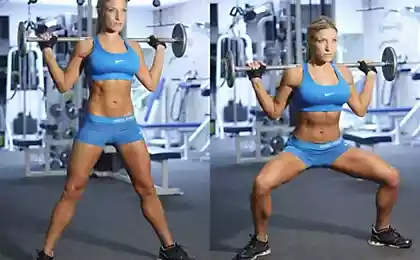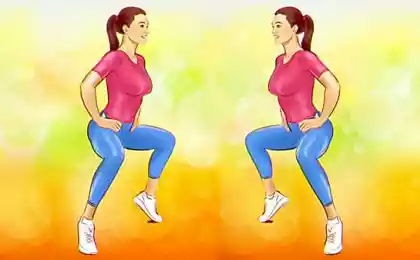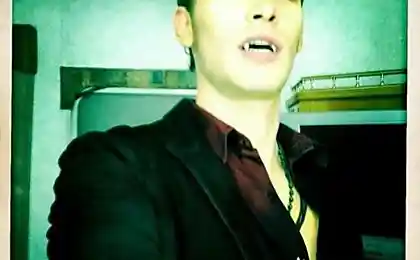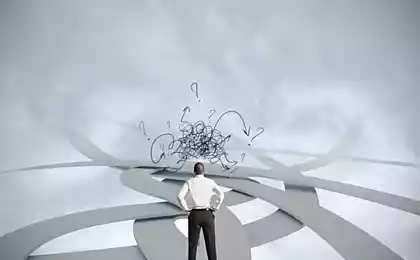622
Turkish sit-UPS: secrets of the strongmen of yore
Exercise program with weights – EcoDynamics load for the whole body, uniting in one training exercise for the cardiovascular system, the resistance and increase range of motion. High-intensity interval training (HIIT) with weights burn more calories per minute than any other exercise.
Recently for weights was adapted from one known in the history of exercisesTurkish sit-UPS. To do this, from a prone position on the floor in one motion to his feet, always holding the weight over your head – usually a weight.

It is believed that this exercise was invented by ancient fighters on the territory of modern Turkey in order to prepare for the grueling competitions.
Legend also says that when in the old days, the athletes came to ask the disciples, wanting sent back, saying he will not accept, yet the student will not be able to perform one Turkish squat with weight 50 kg.Only then began the real learning.
But, in addition to history, that the squat is a difficult task, but with an impressively long list of useful features, if you perform the exercise correctly, and the added benefit – they almost don't need equipment, only weight.
I personally try to do them several times a month with a weight 16 kg weight. well, it makes you sweat. Let's find out how to do a Turkish sit-UPS to get the highest possible return and don't hurt yourself:
The benefits Turkish sit-UPSTurkish squat is not one movement, but several are interrelated, incorporating all three planes of motion. Hold the weight over your head throughout the exercises hard enough for the corps, you must keep the torso upright when you lean, curl and do a lunge.
In addition to building strength, Turkish sit-UPS increase the overall stability of the body, body awareness, balance and coordination. Very few exercises can boast so many advantages. The list of effects is really impressive!
Improves the stability of the upper part of the body
Improves the stability of the lower part of the body
Promotes cross lateralization (when the right hemisphere of the brain works with the left side of the body)
Connects right hand and left leg, and left hand with right foot
Improves the coordinated operation of the upper and lower extremities
Automatic contributes to the stability of the trunk and extremities
Stimulates the vestibular system, contributing to the development of balance
Stimulates visual apparatus, contributing to the development of balance
Stimulates the system proprioceptorov are contributing to the development of balance
Develops shift weight front/rear
Develops strength of the upper body, body and thighs
Contributes to orientation in space
The stability of the shoulder in open and closed circuit
Promote the expansion and rotation of the thorax
Improves mobility and active flexibility of the legs and hips
Improves rotational and straight line stability
Stability in two different leg positions –the position of the lunge and the squat
The stability of the thigh of one leg during the initial roll to press and when performing bridge
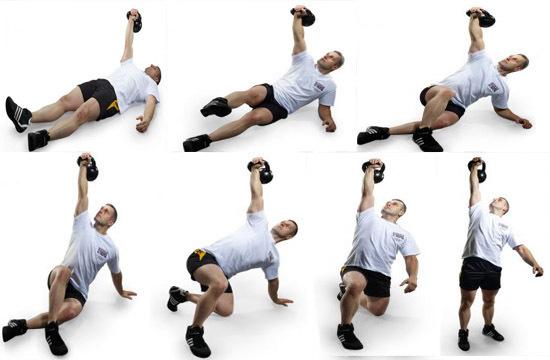
Turkish situps: 13 is not the most easy stepsSTEP 1: starting position
Lie on the floor on his back. The weight put near the right shoulder.
STEP 2: Lift weights
Roll over it's necessary to right, pressing the right elbow to the body, and take a dumbbell in your right hand. Then roll over it's necessary for the back and carefully lower the kettlebell to your chest. Left arm extended on the floor, at an angle of about 45 degrees to the body.
The left leg straight. Bend your right leg so that the foot was pressed to the floor. The right hand slowly raise the weight up, straightening your right elbow. Constantly keep your eye on my weights for the whole time of the exercise.
STEP 3: On the elbow
Firmly resting the right foot to the floor, roll over it's necessary for the left elbow while holding the weight at the top. It looks like a partial squat, relying on the elbow – you must rely on your left buttock.
STEP 4: On hand
When you rely steadily on the elbow, keep rolling until you start to rely on his left hand. Now you have three points of support –left hand, right foot and left buttock.
STEP 5: High bridge
Tighten your buttocks and lift the hips from the ground, holding the arm is perfectly vertical. The eye does not distract from the weights! Now you have only two points of support (left arm and right leg), since the thigh is no longer touching the ground.
STEP 6: Bend the leg
When hips are lifted high, bend left leg under him, back to the place where the knee is on the floor below you. In the end, you should be in a position where the legs will be at an angle of about 90 degrees to each other. One knee is pointing forward and the other to the hand on the floor. The neck should be stretched upwards, look at a weight.
STEP 7: Climb
Lift your left hand off the floor and straighten up. Move the leg standing on the floor until both legs will be parallel to each other in the position of the lunge.
STEP 8: get Up
Starting with the hind legs, through the hips to the front foot, stand in the lunge, while still holding the weight above him, straining his body as soon as you go up. Keep your feet together. Take a breath... half way passed!
STEP 9: Reverse lunge
Make a lunge back to the left knee again sank to the floor. The weight continues to hold up high.
STEP 10: move the leg and turn the hip
Move the left leg until it is perpendicular to the right. Bend your hips and place your left hand directly in front of the knee on the floor.
STEP 11: put forward foot
Extend your left leg forward until it is directly in front of you, press your heel to the floor, supporting himself with his left hand.
STEP 12: Back to the elbow
Very slowly, carefully controlling himself, lower buttocks to the floor, dropping the left forearm.
STEP 13: Finished, repeat
Very slowly lower the body down on the shoulders and back, never taking his eyes off the weights on yourself. Slowly lower it to the stomach. Roll over it's necessary on its side and place it on the floor. Congratulations! The first repetition completed and you are ready for the second.
How to get from squats maximum benefitsTurkish sit-UPS are very intense, involve a lot of moving body parts, so start with light weight (or no) until you master the movement. Try to start instead of weights to take the Shoe – just to understand the correct body mechanics.
As Amy says, Rallo: "don't be surprised if the first time you'll be like drunk". Beginners should start with dumbbells weighing 5 to 7 kg, at best. Nine pounds is an intermediate step for this exercise, and 11-14 kg already experienced. If you just grab the weight for "strong men", you run the risk of injury.
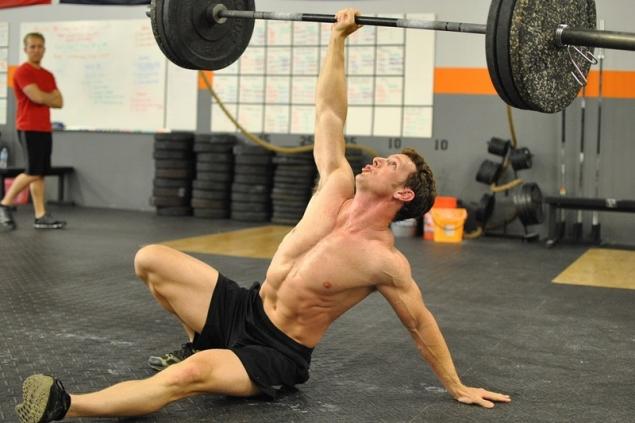
Between each position of the pause and translate breath, mentally checking my form and trying to follow the strength of joints and muscles of the body. If you are unable to properly perform all the repetition, it is better to stop and not to persist, at the risk of injury.
Remember that the benefits from this exercise related to the quality of movement rather than amount of weight. 12-15 reps is fine. On the other hand, you can perform 1-3 repetitions on each side as warm up. Remind yourself not to rush on each repetition should take from 45 to 60 seconds.
Seven common errors: how to fix them:Mistake # 1: improper grip weights
Unlike dumbbells or barbells, grip the kettlebell must be "abundantly" — so that felt a little flexion in the wrist. This is necessary in connection with the displacement of the center of gravity of the weights. It "hangs" below the wrist and on the back side of the forearm, that is, pull your wrist into hyperextension, which increases the likelihood of injury and loss of balance.
The capture of "excess" center of gravity is moved closer to the bones of the hand, resulting in a stronger and more secure position.Imagine that you clench your fist like you're about to hit the heavy bag. The grip should be firm, but not excessive.
Mistake # 2: flexion of elbow
One of the most potentially dangerous mistakes is to bend the elbow lifting the weight. If you even slightly bend the elbow, you will keep the weight only the muscles, not using to support the whole body. When done correctly, Turkish sit-UPS weight is always supported by the passive structures, i.e. a skeleton.
Flexion of the elbow destabilizie the shoulder and increases risk of injury.
Bent arm also excessively straining the triceps, which muscles may get tired, and the weight to fall; this, incidentally, may happen without warning. If this happens, do not attempt to prevent – let down, just shift to the side. If you find it difficult to keep the arm straight, the biceps may unduly strain may be tensile.
If you are unable to perform a Turkish squat with straight arm, follow only those parts with which you get to keep the arm straight. Even partial, of the Turkish squat is a great exercise.
Mistake # 3: beginning exercises with the incorrect position of the lower hand
At the beginning of the movement of the free arm (no weights) must be at an angle of 45 degrees to the body.
Mistake # 4: passive standing
Some mistakenly rolled to the original position of the Turkish sit-UPS, instead of tense and actively move to the first position.
Mistake # 5: Rocking, not rotating
Instead of rotation of the joints, some tend to rock the body, going from three points to two (or from two to three on the way back). Try to rotate the hip joint to fully transfer the weight on the rear knee so it will be easier to rise or lower the hand back on the floor
Mistake # 7: insufficient space
If the body is aligned correctly between the torso, limbs and head will be a certain space. If you lose, you start to rely only on passive means of resistance, as opposed to creating tension and active retention of body positions.
Mistake # 6: relaxation of shoulder and other joints
Shoulders should be "dense", that is, the head of each humerus should be located deep in the articular cavity, to allow you to control your movement and protect the joints and muscles. Imagine that you pulled the blades back. This position will involve the latissimus dorsi, creating a "shelf", which helps to maintain the weight over your head and your weight on the floor.
If this situation fails, you might have to solve the problem with strained muscles, especially the muscles around the shoulder girdle – thoracic, latissimus, triceps and biceps. This also applies to other joints. The shoulders associated with the hip, each shoulder with the opposite hip with the help of the series of fascia.
If you shrug one or both shoulders, the voltage loss will make you strain thigh, which in turn will affect the ability of stretch the abdominal muscles with the rolling and reduce the ability to stand up powerfully in attack. Collectively, these errors put undue stress on vulnerable parts of the body such as the knees and lumbar spine. Ensure that the joints were slightly stretched, not bent. But be careful to avoid hyperextension of the elbows or knees.
Mistake # 7: not activated front housing
Make sure the ribs are facing down, firmly covering the body, throughout the exercise.
published
Author: Dr. Joseph Mercola
P. S. And remember, only by changing their consumption — together we change the world! ©
Source: russian.mercola.com/sites/articles/archive/2016/11/04/%D1%82%D1%83%D1%80%D0%B5%D1%86%D0%BA%D0%B8%D0%B5-%D0%BF%D1%80%D0%B8%D1%81%D0%B5%D0%B4%D0%B0%D0%BD%D0%B8%D1%8F.aspx
Recently for weights was adapted from one known in the history of exercisesTurkish sit-UPS. To do this, from a prone position on the floor in one motion to his feet, always holding the weight over your head – usually a weight.

It is believed that this exercise was invented by ancient fighters on the territory of modern Turkey in order to prepare for the grueling competitions.
Legend also says that when in the old days, the athletes came to ask the disciples, wanting sent back, saying he will not accept, yet the student will not be able to perform one Turkish squat with weight 50 kg.Only then began the real learning.
But, in addition to history, that the squat is a difficult task, but with an impressively long list of useful features, if you perform the exercise correctly, and the added benefit – they almost don't need equipment, only weight.
I personally try to do them several times a month with a weight 16 kg weight. well, it makes you sweat. Let's find out how to do a Turkish sit-UPS to get the highest possible return and don't hurt yourself:
The benefits Turkish sit-UPSTurkish squat is not one movement, but several are interrelated, incorporating all three planes of motion. Hold the weight over your head throughout the exercises hard enough for the corps, you must keep the torso upright when you lean, curl and do a lunge.
In addition to building strength, Turkish sit-UPS increase the overall stability of the body, body awareness, balance and coordination. Very few exercises can boast so many advantages. The list of effects is really impressive!
Improves the stability of the upper part of the body
Improves the stability of the lower part of the body
Promotes cross lateralization (when the right hemisphere of the brain works with the left side of the body)
Connects right hand and left leg, and left hand with right foot
Improves the coordinated operation of the upper and lower extremities
Automatic contributes to the stability of the trunk and extremities
Stimulates the vestibular system, contributing to the development of balance
Stimulates visual apparatus, contributing to the development of balance
Stimulates the system proprioceptorov are contributing to the development of balance
Develops shift weight front/rear
Develops strength of the upper body, body and thighs
Contributes to orientation in space
The stability of the shoulder in open and closed circuit
Promote the expansion and rotation of the thorax
Improves mobility and active flexibility of the legs and hips
Improves rotational and straight line stability
Stability in two different leg positions –the position of the lunge and the squat
The stability of the thigh of one leg during the initial roll to press and when performing bridge

Turkish situps: 13 is not the most easy stepsSTEP 1: starting position
Lie on the floor on his back. The weight put near the right shoulder.
STEP 2: Lift weights
Roll over it's necessary to right, pressing the right elbow to the body, and take a dumbbell in your right hand. Then roll over it's necessary for the back and carefully lower the kettlebell to your chest. Left arm extended on the floor, at an angle of about 45 degrees to the body.
The left leg straight. Bend your right leg so that the foot was pressed to the floor. The right hand slowly raise the weight up, straightening your right elbow. Constantly keep your eye on my weights for the whole time of the exercise.
STEP 3: On the elbow
Firmly resting the right foot to the floor, roll over it's necessary for the left elbow while holding the weight at the top. It looks like a partial squat, relying on the elbow – you must rely on your left buttock.
STEP 4: On hand
When you rely steadily on the elbow, keep rolling until you start to rely on his left hand. Now you have three points of support –left hand, right foot and left buttock.
STEP 5: High bridge
Tighten your buttocks and lift the hips from the ground, holding the arm is perfectly vertical. The eye does not distract from the weights! Now you have only two points of support (left arm and right leg), since the thigh is no longer touching the ground.
STEP 6: Bend the leg
When hips are lifted high, bend left leg under him, back to the place where the knee is on the floor below you. In the end, you should be in a position where the legs will be at an angle of about 90 degrees to each other. One knee is pointing forward and the other to the hand on the floor. The neck should be stretched upwards, look at a weight.
STEP 7: Climb
Lift your left hand off the floor and straighten up. Move the leg standing on the floor until both legs will be parallel to each other in the position of the lunge.
STEP 8: get Up
Starting with the hind legs, through the hips to the front foot, stand in the lunge, while still holding the weight above him, straining his body as soon as you go up. Keep your feet together. Take a breath... half way passed!
STEP 9: Reverse lunge
Make a lunge back to the left knee again sank to the floor. The weight continues to hold up high.
STEP 10: move the leg and turn the hip
Move the left leg until it is perpendicular to the right. Bend your hips and place your left hand directly in front of the knee on the floor.
STEP 11: put forward foot
Extend your left leg forward until it is directly in front of you, press your heel to the floor, supporting himself with his left hand.
STEP 12: Back to the elbow
Very slowly, carefully controlling himself, lower buttocks to the floor, dropping the left forearm.
STEP 13: Finished, repeat
Very slowly lower the body down on the shoulders and back, never taking his eyes off the weights on yourself. Slowly lower it to the stomach. Roll over it's necessary on its side and place it on the floor. Congratulations! The first repetition completed and you are ready for the second.
How to get from squats maximum benefitsTurkish sit-UPS are very intense, involve a lot of moving body parts, so start with light weight (or no) until you master the movement. Try to start instead of weights to take the Shoe – just to understand the correct body mechanics.
As Amy says, Rallo: "don't be surprised if the first time you'll be like drunk". Beginners should start with dumbbells weighing 5 to 7 kg, at best. Nine pounds is an intermediate step for this exercise, and 11-14 kg already experienced. If you just grab the weight for "strong men", you run the risk of injury.

Between each position of the pause and translate breath, mentally checking my form and trying to follow the strength of joints and muscles of the body. If you are unable to properly perform all the repetition, it is better to stop and not to persist, at the risk of injury.
Remember that the benefits from this exercise related to the quality of movement rather than amount of weight. 12-15 reps is fine. On the other hand, you can perform 1-3 repetitions on each side as warm up. Remind yourself not to rush on each repetition should take from 45 to 60 seconds.
Seven common errors: how to fix them:Mistake # 1: improper grip weights
Unlike dumbbells or barbells, grip the kettlebell must be "abundantly" — so that felt a little flexion in the wrist. This is necessary in connection with the displacement of the center of gravity of the weights. It "hangs" below the wrist and on the back side of the forearm, that is, pull your wrist into hyperextension, which increases the likelihood of injury and loss of balance.
The capture of "excess" center of gravity is moved closer to the bones of the hand, resulting in a stronger and more secure position.Imagine that you clench your fist like you're about to hit the heavy bag. The grip should be firm, but not excessive.
Mistake # 2: flexion of elbow
One of the most potentially dangerous mistakes is to bend the elbow lifting the weight. If you even slightly bend the elbow, you will keep the weight only the muscles, not using to support the whole body. When done correctly, Turkish sit-UPS weight is always supported by the passive structures, i.e. a skeleton.
Flexion of the elbow destabilizie the shoulder and increases risk of injury.
Bent arm also excessively straining the triceps, which muscles may get tired, and the weight to fall; this, incidentally, may happen without warning. If this happens, do not attempt to prevent – let down, just shift to the side. If you find it difficult to keep the arm straight, the biceps may unduly strain may be tensile.
If you are unable to perform a Turkish squat with straight arm, follow only those parts with which you get to keep the arm straight. Even partial, of the Turkish squat is a great exercise.
Mistake # 3: beginning exercises with the incorrect position of the lower hand
At the beginning of the movement of the free arm (no weights) must be at an angle of 45 degrees to the body.
Mistake # 4: passive standing
Some mistakenly rolled to the original position of the Turkish sit-UPS, instead of tense and actively move to the first position.
Mistake # 5: Rocking, not rotating
Instead of rotation of the joints, some tend to rock the body, going from three points to two (or from two to three on the way back). Try to rotate the hip joint to fully transfer the weight on the rear knee so it will be easier to rise or lower the hand back on the floor
Mistake # 7: insufficient space
If the body is aligned correctly between the torso, limbs and head will be a certain space. If you lose, you start to rely only on passive means of resistance, as opposed to creating tension and active retention of body positions.
Mistake # 6: relaxation of shoulder and other joints
Shoulders should be "dense", that is, the head of each humerus should be located deep in the articular cavity, to allow you to control your movement and protect the joints and muscles. Imagine that you pulled the blades back. This position will involve the latissimus dorsi, creating a "shelf", which helps to maintain the weight over your head and your weight on the floor.
If this situation fails, you might have to solve the problem with strained muscles, especially the muscles around the shoulder girdle – thoracic, latissimus, triceps and biceps. This also applies to other joints. The shoulders associated with the hip, each shoulder with the opposite hip with the help of the series of fascia.
If you shrug one or both shoulders, the voltage loss will make you strain thigh, which in turn will affect the ability of stretch the abdominal muscles with the rolling and reduce the ability to stand up powerfully in attack. Collectively, these errors put undue stress on vulnerable parts of the body such as the knees and lumbar spine. Ensure that the joints were slightly stretched, not bent. But be careful to avoid hyperextension of the elbows or knees.
Mistake # 7: not activated front housing
Make sure the ribs are facing down, firmly covering the body, throughout the exercise.
published
Author: Dr. Joseph Mercola
P. S. And remember, only by changing their consumption — together we change the world! ©
Source: russian.mercola.com/sites/articles/archive/2016/11/04/%D1%82%D1%83%D1%80%D0%B5%D1%86%D0%BA%D0%B8%D0%B5-%D0%BF%D1%80%D0%B8%D1%81%D0%B5%D0%B4%D0%B0%D0%BD%D0%B8%D1%8F.aspx
How to communicate with elderly parents: 10 simple rules
Read ALL! As sugar destroys the liver and brain




